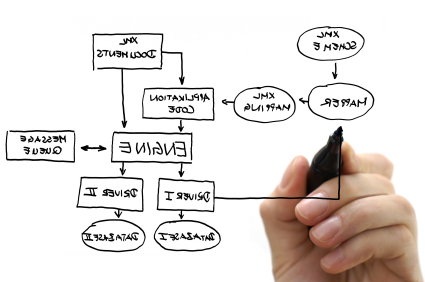Plato would be right at home pitching an idea to a full room of VCs in Silicon Valley. Instead of delivering straightforward instruction, he made dialogue the center of focus for developing his ideas and getting others to see his point of view. Even the Ancient Greeks knew that effective communication does not follow a linear path—it requires us to incorporate the point of view of others as we engage in cooperative, iterative learning together.
In most of Plato’s writings, the protagonist Socrates engages in a conversation with another person. During a back and forth exchange, Socrates makes his “pitch” by learning more about the other person’s point of view. Through nonlinear give and take, everyone comes away better informed.
Transforming one-way presentations into a shared environment for developing knowledge together allows our expertise to come alive. This is crucial for several reasons:
We meet people on the same plane: By adopting each other’s point of view, we communicate on the same page and cut down on misunderstandings and misinterpretations.
We develop our own knowledge further: Delivering information shouldn’t be a one-way street. Pushback by others forces us to refine and sharpen our own ideas.
We go beyond the content at hand: By using our knowledge as a roadmap for jumping off into a dialogue of learning, we avoid constraining the potential of our meetings by simply “sticking to the script.”
Plato understood that the best way to communicate some of our most complicated ideas might be to develop them together in shared dialogue. Focusing on conversation, rather than instruction, allows us to engage all participants in the learning process. When we engage in learning dialogue, we iteratively develop our own expertise to synchronize each other’s perspectives and maximize the richness of the ideas being shared.
William Isaacs’ critical book, Dialogue: The Art of Thinking Together, elucidates this point further. Isaacs wants us to understand that cogent dialogue isn’t just about passing ideas back and forth. By engaging the collective knowledge of everyone in the group, a truly effective pitch creates synergy that both unifies the group and expands its creative capabilities.
Thus, the heart of effective communication lies in establishing a relationship through which information can be shared. By building a bridge of respect and trust, ideas belong to the group and individual problems become the focus of cooperative effort.
Engaging in nonlinear dialogue adds a personal element to communication, and this is critical. Oren Jacob has spent over 20 years developing and fielding pitches. Between pitching $100 million movies at Pixar, fielding startup pitches as an EIR at August Capital, and now as co-founder and CEO of interactive media company ToyTalk, he knows an effective pitch inside and out. He makes a keen observation: “Your pitch has to be infused with humanity.”
Much of this is really about flexibility. Jacob continues, “You’re at your most human when you can respond off the cuff.” He argues that while stories require structure, they are really a conversation. Navigating the connections that structure the transitions between key points is a subtle, but important tool. Jacob suggests practicing delivering pitches in a nonlinear way to hone this skill, explaining, “It’s only by working the transitions in and out of your key points that you’ll actually get a real handle on the various bridges you can use to get where you need to be.”
At Vimodi, we are developing technology that helps users have a more engaging, responsive and effective visual discussions and dialogues. Vimodi enables visual mobile discussions for better engagement, motivation, and creativity in meetings and daily communication. Try Vimodi App.
In most of Plato’s writings, the protagonist Socrates engages in a conversation with another person. During a back and forth exchange, Socrates makes his “pitch” by learning more about the other person’s point of view. Through nonlinear give and take, everyone comes away better informed.
Transforming one-way presentations into a shared environment for developing knowledge together allows our expertise to come alive. This is crucial for several reasons:
We meet people on the same plane: By adopting each other’s point of view, we communicate on the same page and cut down on misunderstandings and misinterpretations.
We develop our own knowledge further: Delivering information shouldn’t be a one-way street. Pushback by others forces us to refine and sharpen our own ideas.
We go beyond the content at hand: By using our knowledge as a roadmap for jumping off into a dialogue of learning, we avoid constraining the potential of our meetings by simply “sticking to the script.”
Plato understood that the best way to communicate some of our most complicated ideas might be to develop them together in shared dialogue. Focusing on conversation, rather than instruction, allows us to engage all participants in the learning process. When we engage in learning dialogue, we iteratively develop our own expertise to synchronize each other’s perspectives and maximize the richness of the ideas being shared.
William Isaacs’ critical book, Dialogue: The Art of Thinking Together, elucidates this point further. Isaacs wants us to understand that cogent dialogue isn’t just about passing ideas back and forth. By engaging the collective knowledge of everyone in the group, a truly effective pitch creates synergy that both unifies the group and expands its creative capabilities.
Thus, the heart of effective communication lies in establishing a relationship through which information can be shared. By building a bridge of respect and trust, ideas belong to the group and individual problems become the focus of cooperative effort.
Engaging in nonlinear dialogue adds a personal element to communication, and this is critical. Oren Jacob has spent over 20 years developing and fielding pitches. Between pitching $100 million movies at Pixar, fielding startup pitches as an EIR at August Capital, and now as co-founder and CEO of interactive media company ToyTalk, he knows an effective pitch inside and out. He makes a keen observation: “Your pitch has to be infused with humanity.”
Much of this is really about flexibility. Jacob continues, “You’re at your most human when you can respond off the cuff.” He argues that while stories require structure, they are really a conversation. Navigating the connections that structure the transitions between key points is a subtle, but important tool. Jacob suggests practicing delivering pitches in a nonlinear way to hone this skill, explaining, “It’s only by working the transitions in and out of your key points that you’ll actually get a real handle on the various bridges you can use to get where you need to be.”
At Vimodi, we are developing technology that helps users have a more engaging, responsive and effective visual discussions and dialogues. Vimodi enables visual mobile discussions for better engagement, motivation, and creativity in meetings and daily communication. Try Vimodi App.





